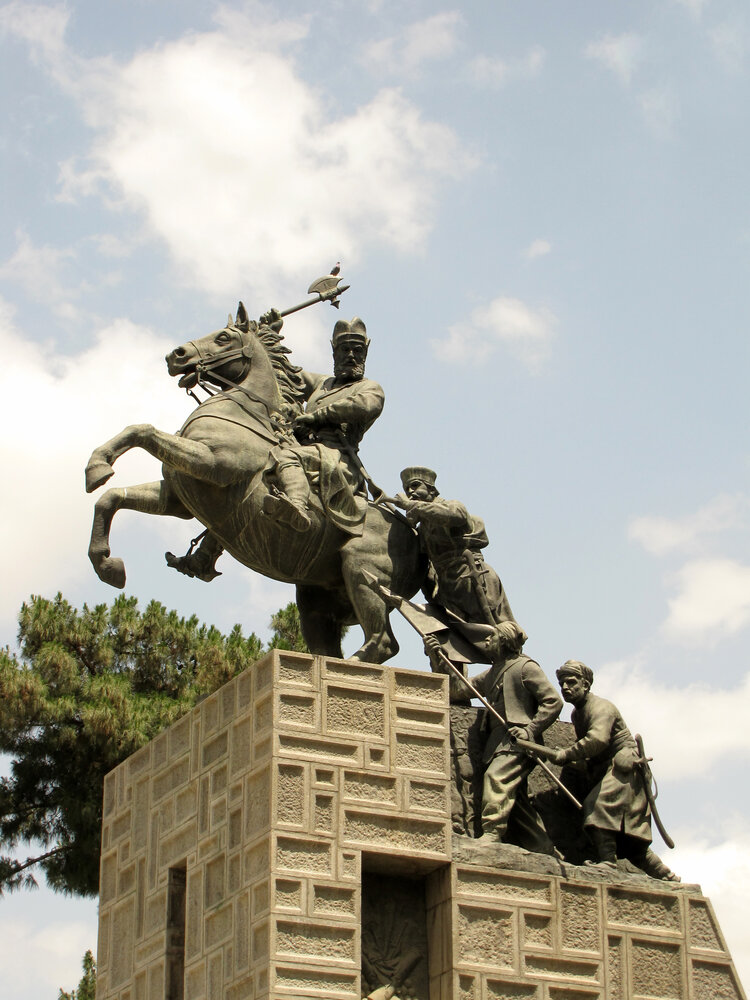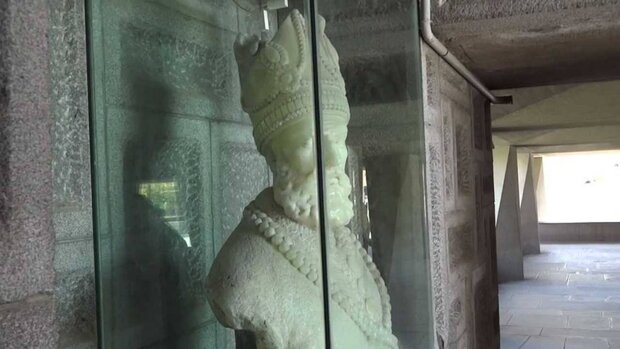Mausoleum, where ‘Napoleon of Persia’ is laid to rest

TEHRAN— Elsewhere in Iran, Nader Shah (August 1688 – 19 June 1747) might be considered someone like a historical tyrant. But here he is a national hero.
He reformed Iran’s military forces and utterly defeated Afghans in a series of brilliant victories, after which he restored Tahmasp to the Iranian throne.
Born Nader Qoli Beg, Nader created an Iranian empire that stretched from the Indus River to the Caucasus Mountains. He is widely considered one of the most powerful rulers in the history of the nation. He assumed power when a period of chaos overwhelmed Iran.
Modern travelers to Mashhad, northeast Iran, may visit Nader’s equestrian statue, which crowns his otherwise dour grey-granite mausoleum. Moreover, there is a small museum displaying guns, a rhino-hide shield, and a carpet portrait of Nader on horseback.
The mausoleum is surmounted by an impressive equestrian statue depicting the monarch holding an ax, the work of renowned Iranian sculptor Abolhassan Sadiqi.
The museum showcases various objects from the introduction of the Afsharay period such as weapons, rare paintings, and scenes of war, horseback riding objects, rare swords, and several manuscripts, to name a few. Moreover, it displays a variety of coins, dishes, and other objects from the Safavid to the contemporary period.
Nader endeavored to reunite the Persian realm while repelling invaders. He is sometimes referred to as the Napoleon of Persia or the Second Alexander.
According to Encyclopedia Britannica, Nader Qoli Beg had an obscure beginning in the Turkish Afshar tribe, which was loyal to the Safavid shahs of Iran. After serving under a local chieftain, Nader formed and led a band of robbers, showing marked powers of leadership.
With the navy he proceeded to build, Nader Shah was able not only to take Bahrain from the Arabs but also to invade and conquer Oman. In February 1739, after capturing several cities of the Mughal Empire of northern India, he moved against the main Mughal armies at Karnal, India. He won the battle and entered Delhi, returning to Iran with vast amounts of loot, including the fabulous Peacock Throne and the Koh-e-Noor Diamond. He then attacked the Uzbeks around the cities of Bukhara and Khiva; his empire had reached its furthest expansion and rivaled the territorial extent of the ancient Iranian empires.
In 1741, after an assassination attempt on him had failed, Nader Shah suspected his eldest son of complicity and had him blinded. In 1743, Nader Shah again attacked the Ottoman Turks, but revolts in Iran forced him to conclude a truce. He renewed hostilities with the Turks as soon as possible, winning a great victory over them near Yerevan. Peace was concluded in 1746.
Although brilliantly successful as a soldier and general, Nader Shah had little talent for statesmanship or administration, and Iran became utterly exhausted during the later years of his reign.

Tens of thousands of people perished in his ceaseless military campaigns, and the exactions of his tax-gatherers ruined the country’s economy. Nader Shah had always been harsh and ruthless, but these traits became more pronounced as he grew older. His suspiciousness and capricious cruelty continued to grow, and wherever he went, he had people tortured and executed. The consequence was that revolt after revolt against him occurred. In the end, he was assassinated by his own troops while attempting to crush an uprising in Khorasan. Nader Shah’s only interests were war and conquest. Once, when informed that there was no warfare in paradise, he remarked: “How then can there be any delights there?”
Under tourists’ eyes
Here is a selection of comments on the mausoleum and museum that foreign visitors have already posted to TripAdvisor:
“The East Napoleon”
The tomb of Nader Shah is located in downtown Mashhad. It is designed as a tent because Nader Shah was always in the way of wars to overbear the revolts. There is also a small museum in the area.
“A great museum”
Nader Shah Afshar, the powerful Iranian king of the earth, has devoted himself to aggressors to regain and expand the borders of his land, his life, and his youth. It was very interesting to see the text there. The Musee Naderi has two halls, the first hall displays various objects from the introduction of the Afsharay period, and the second hall includes a variety of coins, dishes, and other objects from the Safavid to the contemporary period. The war ball belonging to the time of the reign near the tomb tower is the booty of Iranian men from the Portuguese war. At the Museum of the Arms, weapons of the Afsharian period, rare paintings and scenes of war, horseback riding like the horse saddle from Afshariyah to Qajar era, two rare swords, as well as several manuscripts, including the rare universe history. On the northern corner of Naderi Gardens is the tomb of Colonel Mohammad Taghi Khan Pasayan. He was a late Qajarian soldier and the first Iranian man to complete his graduate training course. He made the design of the stone grave of Mohammad Taghi Khan Persian by Hooshang Seyhoun. (amrov222 from Oslo, Norway)
“So so”
This tomb is located in a small park and there is a small fee to enter. Hardly any people around, so you will have the whole place to yourself and be done in 15 minutes. So, apart from the tomb and a massive statue, there is a museum of sorts. He was one of the more powerful rulers and lived in the 1700s. Ok for a half-hour tour. (SalimM from London)
“A dull, concrete nothing”
Nadir (Nader) Shah was a very important figure in Persian/Iranian history, and especially important to this part of the country; it's a great shame that his monument does so little justice to his legacy. (Andrew W from Somerville, the U.S.)
“Great piece of history”
It s one of the monuments you don't want to miss in Mashhad especially if you are a Persian. It is the tomb of one of the great kings of Persia. (Roxana J from Milan)
AFM
Leave a Comment